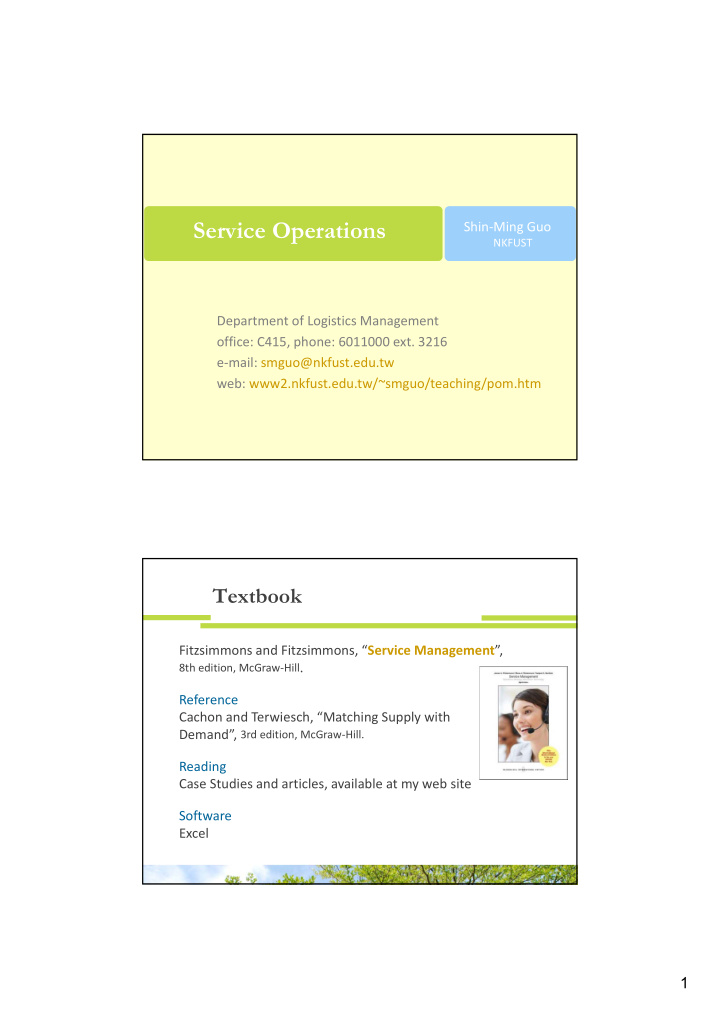



Service Operations Shin ‐ Ming Guo NKFUST Department of Logistics Management office: C415, phone: 6011000 ext. 3216 e ‐ mail: smguo@nkfust.edu.tw web: www2.nkfust.edu.tw/~smguo/teaching/pom.htm Textbook Fitzsimmons and Fitzsimmons, “ Service Management ”, 8th edition, McGraw ‐ Hill . Reference Cachon and Terwiesch, “Matching Supply with Demand”, 3rd edition, McGraw ‐ Hill. Reading Case Studies and articles, available at my web site Software Excel 1
Tentative Course Outline 1 Introduction 2 ‐ 3 Service Strategy and Service Packages 4 New Service Development 7 ‐ 8 Process Flows and Improvement 9 Service Encounter 11 Managing Capacity and Demand 12 Managing Waiting Lines 18 Managing Service Inventory Grading Homework 30% Report 30% Final Exam 30% Participation 10% No Plagiarism, No Cheating 2
Old Topics for Team Report Loan Processing at Capital One — Wharton School Great Italian Cuisine without the Wait — HBS Taco Bell Corp. — HBR British Columbia NICU Bed Allocation — University of W. Ontario Which Products Should You Stock? — HBR The Morrison Company: redesigning the manufacturing process — HBR What is Service? Tangible or intangible? Customer involvement? Standardization or customization? Human or machine processing? Inventory and leftover? A service is a time ‐ perishable, intangible experience performed for a customer acting in the role of co ‐ producer. 3
Compare Manufacturing & Service Characteristic Manufacturing Service Product Tangible Tangible & Intangible Customer involvement Low High Uniformity of input High Low Labor content Low High Uniformity of output High Low Performance Measurement Easy Difficult Quality Control High Low Inventory Much Little or Perishable 4
Moving to Experience Economy Economy Agrarian Industrial Service Experience Economic Food Packaged Commodity Consumer Business Offering goods service services services Function Extract Make Deliver Stage Co ‐ create Nature Fungible Tangible Intangible Memorable Effectual Attribute Natural Standardized Customized Personal Growth Method of Stored in Inventoried Delivered Revealed Sustained Supply bulk on demand over time over time Seller Trader Producer Provider Stager Collaborator Buyer Market Customer Client Guest Collaborator Expectation Quantity Features Benefits Sensations Capability What is Operation Management? Transformation = Production = Service Physical: restaurants Location: transportation Exchange: retailing Storage: warehousing Physiological: health care Informational: telecommunications 5
How Can OM Help a Business? Low Cost? Fast Delivery? Quality Service? Better Selection? Four Dimensions of Tradeoffs Cost Quality ▪ Product quality ▪ Efficiency ▪ Measured by: (how good?) ▪ Process quality ‐ cost per unit (as good as promised?) ‐ utilization Time Variety ▪ Responsiveness to demand ▪ Customer heterogeneity ▪ Measured by: ▪ Measured by: ‐ customer lead time ‐ number of options ‐ flow time ‐ flexibility / set ‐ ups 6
1st Use: Remove Inefficiencies High Current frontier In the industry Competitor A Responsiveness Competitor C Eliminate inefficiencies Competitor B Low Low Labor Productivity High It’s Details that Count Speed and Convenience for Passengers! On time performance and Cost for Airlines! needs fine ‐ tuning… 7
2nd Use: Help Making Trade-Offs High Very short waiting times Frequent operator idle time Responsiveness Trade ‐ off Long waiting times, yet operators are almost fully utilized Low Low Labor Productivity High Call Center of Railroad Station Goal: 80% of incoming calls wait less than 20 seconds Starting point: 30% of incoming calls wait less than 20 secs. Problem: Must decide staffing levels of call centers and understand impact on efficiency Solution: Provides tools to support strategic trade ‐ offs 8
3rd Use: Evaluate New Process High Redesign New frontier process Responsiveness Current frontier In the industry Low Low Labor Productivity High 9
Operation is Heart of Business Operations account for 60 to 80% of the direct expenses that burden a firm’s profit. Operations directly affect customers and are essential to the competitiveness of the firm. Service Managers need to perform and make decisions in all functions. 10
Recommend
More recommend